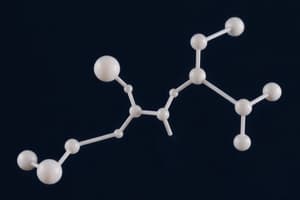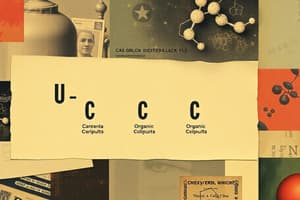Podcast
Questions and Answers
Which of the following best describes monosaccharides?
Which of the following best describes monosaccharides?
- They contain 3-10 monosaccharide units.
- They cannot be further hydrolyzed. (correct)
- They consist of two sugar units.
- They have a molecular formula of $C_n(H_2)$.
How are monosaccharides classified based on their functional groups?
How are monosaccharides classified based on their functional groups?
- Aldoses are sugars with an aldehyde group. (correct)
- Ketoses have a -ose suffix.
- Ketoses contain no carbon atoms.
- Aldoses contain a keto group.
What characterizes disaccharides?
What characterizes disaccharides?
- They are classified only as glucose derivatives.
- They always contain three or more monosaccharide units.
- They cannot be formed from monosaccharides.
- They consist of two sugar units linked through a glycosidic bond. (correct)
Oligosaccharides consist of how many monosaccharide units?
Oligosaccharides consist of how many monosaccharide units?
Which statement about the general molecular formula for carbohydrates is correct?
Which statement about the general molecular formula for carbohydrates is correct?
Flashcards are hidden until you start studying
Study Notes
Carbohydrate Definition
- Carbohydrates are polyhydroxy aldehydes or ketones, or substances that produce these upon hydrolysis.
- The general molecular formula for carbohydrates is $C_n(H_2O)_n$.
- Glucose, for example, has the molecular formula $C_6H_{12}O_6$.
Carbohydrate Classification
- Monosaccharides
- Contain a single sugar unit and cannot be further broken down by hydrolysis.
- Classified based on functional group and number of carbon atoms.
- Aldehyde group: Sugars with an aldehyde functional group are known as aldoses.
- Keto group: Sugars with a keto functional group are known as ketoses, and are sometimes identified by the suffix "-ulose".
- Number of carbon atoms:
- Trioses: 3 carbons
- Tetroses: 4 carbons
- Pentoses: 5 carbons
- Hexoses: 6 carbons
- Heptoses: 7 carbons
- Disaccharides
- Formed by combining two monosaccharides with the removal of a water molecule.
- Oligosaccharides
- Contain 3 to 10 monosaccharide units.
- Polysaccharides
- Contain more than 10 monosaccharide units.
Studying That Suits You
Use AI to generate personalized quizzes and flashcards to suit your learning preferences.




